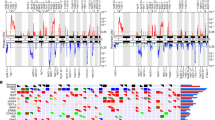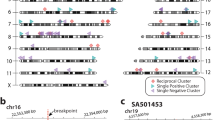Abstract
Hepatocellular carcinoma (HCC) is a cancer of substantial morphologic, genetic and phenotypic diversity. Yet we do not understand the relationship between intratumor heterogeneity and the associated morphologic/histological characteristics of the tumor. Using single-cell whole-genome sequencing to profile 96 tumor cells (30-36 each) and 15 normal liver cells (5 each), collected from three male patients with HBV-associated HCC, we confirmed that copy number variations occur early in hepatocarcinogenesis but thereafter remain relatively stable throughout tumor progression. Importantly, we showed that specific HCCs can be of monoclonal or polyclonal origins. Tumors with confluent multinodular morphology are the typical polyclonal tumors and display the highest intratumor heterogeneity. In addition to mutational and copy number profiles, we dissected the clonal origins of HCC using HBV-derived foreign genomic markers. In monoclonal HCC, all the tumor single cells exhibit the same HBV integrations, indicating that HBV integration is an early driver event and remains extremely stable during tumor progression. In addition, our results indicated that both models of metastasis, late dissemination and early seeding, have a role in HCC progression. Notably, early intrahepatic spreading of the initiating clone leads to the formation of synchronous multifocal tumors. Meanwhile, we identified a potential driver gene ZNF717 in HCC, which exhibits a high frequency of mutation at both single-cell and population levels, as a tumor suppressor acting through regulating the IL-6/STAT3 pathway. These findings highlight multiple distinct tumor evolutionary mechanisms in HCC, which suggests the need for specific treatment strategies.
Similar content being viewed by others
Log in or create a free account to read this content
Gain free access to this article, as well as selected content from this journal and more on nature.com
or
References
Torre LA, Bray F, Siegel RL, Ferlay J, Lortet-Tieulent J, Jemal A . Global cancer statistics, 2012. CA Cancer J Clin 2015; 65:87–108.
Friemel J, Rechsteiner M, Frick L, et al. Intratumor heterogeneity in hepatocellular carcinoma. Clin Cancer Res 2015; 21:1951–1961.
Xue R, Li R, Guo H, et al. Variable intra-tumor genomic heterogeneity of multiple lesions in patients with hepatocellular carcinoma. Gastroenterology 2016; 150:998–1008.
Shi JY, Xing Q, Duan M, et al. Inferring the progression of multifocal liver cancer from spatial and temporal genomic heterogeneity. Oncotarget 2016; 7:2867–2877.
Ling S, Hu Z, Yang Z, et al. Extremely high genetic diversity in a single tumor points to prevalence of non-Darwinian cell evolution. Proc Natl Acad Sci USA 2015; 112:E6496–E6505.
Gao Q, Wang ZC, Duan M, et al. Cell culture system for analysis of genetic heterogeneity within hepatocellular carcinomas and response to pharmacologic agents. Gastroenterology 2017; 152:232–242.
Weiskirchen R . Intratumor heterogeneity, variability and plasticity: questioning the current concepts in classification and treatment of hepatocellular carcinoma. Hepatobiliary Surg Nutr 2016; 5:183–187.
Gawad C, Koh W, Quake SR . Single-cell genome sequencing: current state of the science. Nat Rev Genet 2016; 17:175–188.
Wang Y, Navin NE . Advances and applications of single-cell sequencing technologies. Mol Cell 2015; 58:598–609.
Navin N, Kendall J, Troge J, et al. Tumour evolution inferred by single-cell sequencing. Nature 2011; 472:90–94.
Wang Y, Waters J, Leung ML, et al. Clonal evolution in breast cancer revealed by single nucleus genome sequencing. Nature 2014; 512:155–160.
Xu X, Hou Y, Yin X, et al. Single-cell exome sequencing reveals single-nucleotide mutation characteristics of a kidney tumor. Cell 2012; 148:886–895.
Li Y, Xu X, Song L, et al. Single-cell sequencing analysis characterizes common and cell-lineage-specific mutations in a muscle-invasive bladder cancer. GigaScience 2012; 1:12.
Yu C, Yu J, Yao X, et al. Discovery of biclonal origin and a novel oncogene SLC12A5 in colon cancer by single-cell sequencing. Cell Res 2014; 24:701–712.
Martelotto LG, Baslan T, Kendall J, et al. Whole-genome single-cell copy number profiling from formalin-fixed paraffin-embedded samples. Nat Med 2017; 23:376–385.
Hou Y, Guo H, Cao C, et al. Single-cell triple omics sequencing reveals genetic, epigenetic, and transcriptomic heterogeneity in hepatocellular carcinomas. Cell Res 2016; 26:304–319.
Murakata A, Tanaka S, Mogushi K, et al. Gene expression signature of the gross morphology in hepatocellular carcinoma. Ann Surg 2011; 253:94–100.
Budhu A, Forgues M, Ye QH, et al. Prediction of venous metastases, recurrence, and prognosis in hepatocellular carcinoma based on a unique immune response signature of the liver microenvironment. Cancer Cell 2006; 10:99–111.
Miao R, Luo H, Zhou H, et al. Identification of prognostic biomarkers in hepatitis B virus-related hepatocellular carcinoma and stratification by integrative multi-omics analysis. J Hepatol 2014; 60:346–353.
Zong C, Lu S, Chapman AR, Xie XS . Genome-wide detection of single-nucleotide and copy-number variations of a single human cell. Science 2012; 338:1622–1626.
Li L, Wang H . Heterogeneity of liver cancer and personalized therapy. Cancer Lett 2016; 379:191–197.
Pesi B, Ferrero A, Grazi GL, et al. Liver resection with thrombectomy as a treatment of hepatocellular carcinoma with major vascular invasion: results from a retrospective multicentric study. Am J Surg 2015; 210:35–44.
Gao Q, Wang XY, Zhou J, Fan J . Multiple carcinogenesis contributes to the heterogeneity of HCC. Nat Rev Gastroenterol Hepatol 2015; 12:13.
He J, Shi J, Fu X, et al. The clinicopathologic and prognostic significance of gross classification on solitary hepatocellular carcinoma after hepatectomy. Medicine 2015; 94:e1331.
Ringelhan M, O'Connor T, Protzer U, Heikenwalder M . The direct and indirect roles of HBV in liver cancer: prospective markers for HCC screening and potential therapeutic targets. J Pathol 2015; 235:355–367.
Sung WK, Zheng H, Li S, et al. Genome-wide survey of recurrent HBV integration in hepatocellular carcinoma. Nat Genet 2012; 44:765–769.
Ding D, Lou X, Hua D, et al. Recurrent targeted genes of hepatitis B virus in the liver cancer genomes identified by a next-generation sequencing-based approach. PLoS Genet 2012; 8:e1003065.
Chen M, Song P, Zou D, et al. Comparison of multiple displacement amplification (MDA) and multiple annealing and looping-based amplification cycles (MALBAC) in single-cell sequencing. PLoS One 2014; 9:e114520.
Oriyama T, Yamanaka N, Fujimoto J, Ichikawa N, Okamoto E . Progression of hepatocellular carcinoma as reflected by nuclear DNA ploidy and cellular differentiation. J Hepatol 1998; 28:142–149.
Futreal PA, Coin L, Marshall M, et al. A census of human cancer genes. Nat Rev Cancer 2004; 4:177–183.
Schulze K, Imbeaud S, Letouze E, et al. Exome sequencing of hepatocellular carcinomas identifies new mutational signatures and potential therapeutic targets. Nat Genet 2015; 47:505–511.
Totoki Y, Tatsuno K, Covington KR, et al. Trans-ancestry mutational landscape of hepatocellular carcinoma genomes. Nat Genet 2014; 46:1267–1273.
Ahn SM, Jang SJ, Shim JH, et al. Genomic portrait of resectable hepatocellular carcinomas: implications of RB1 and FGF19 aberrations for patient stratification. Hepatology 2014; 60:1972–1982.
Cleary SP, Jeck WR, Zhao X, et al. Identification of driver genes in hepatocellular carcinoma by exome sequencing. Hepatology 2013; 58:1693–1702.
Tamborero D, Gonzalez-Perez A, Lopez-Bigas N . OncodriveCLUST: exploiting the positional clustering of somatic mutations to identify cancer genes. Bioinformatics 2013; 29:2238–2244.
Chen Y, Wang L, Xu H, Liu X, Zhao Y . Exome capture sequencing reveals new insights into hepatitis B virus-induced hepatocellular carcinoma at the early stage of tumorigenesis. Oncol Rep 2013; 30:1906–1912.
Roessler S, Long EL, Budhu A, et al. Integrative genomic identification of genes on 8p associated with hepatocellular carcinoma progression and patient survival. Gastroenterology 2012; 142:957–966.
Roessler S, Jia HL, Budhu A, et al. A unique metastasis gene signature enables prediction of tumor relapse in early-stage hepatocellular carcinoma patients. Cancer Res 2010; 70:10202–10212.
Klein CA . Parallel progression of primary tumours and metastases. Nat Rev Cancer 2009; 9:302–312.
Furuta M, Ueno M, Fujimoto A, et al. Whole genome sequencing discriminates hepatocellular carcinoma with intrahepatic metastasis from multi-centric tumors. J Hepatol 2017; 66:363–373.
Yang Z, He L, Lin K, et al. The KMT1A-GATA3-STAT3 circuit is a novel self-renewal signaling of human bladder cancer stem cells. Clin Cancer Res 2017; 23:6673–6685.
Acknowledgements
This work was supported by the National Natural Science Foundation of China (81522036, 81572292 and 81372648 to QG; 81672956 and 81472413 to CL); Basic Research Project from Technology Commission of Shanghai Municipality (17JC1402200) and National Program for Special Support of Eminent Professionals and Science to QG; the Key Program (QYZDB-SSW-SMC036), External Cooperation Program (GJHZ201312) and the National Key Basic Research Program of China (2015CB856000) to XZ.
Author information
Authors and Affiliations
Corresponding authors
Additional information
( Supplementary information is linked to the online version of the paper on the Cell Research website.)
Supplementary information
Supplementary information, Figure S1
Morphologic and histological features of three HCC used for SCG. (PDF 3362 kb)
Supplementary information, Figure S2
Depth and distribution of coverage for each sequencing library based on SCG (A) and population sequencing (B). (PDF 485 kb)
Supplementary information, Figure S3
Somatic Mutation Pattern Spectrums of each HCC based on SCG. (PDF 264 kb)
Supplementary information, Figure S4
Sanger sequencing validation of 11 HBV integration sites. (PDF 543 kb)
Supplementary information, Figure S5
The technical amplification and sequencing error rate of MALBAC data of the single cell samples. (PDF 234 kb)
Supplementary information, Figure S6
The Q20 and Q30 bases fraction of the single cell samples. (PDF 59 kb)
Supplementary information, Figure S7
Statistical significance of gain and loss regions in the SCGs of the three HCC patients. (PDF 450 kb)
Supplementary information, Figure S8
The mutation landscape and driver-gene prediction. (PDF 227 kb)
Supplementary information, Figure S9
ZNF717 knockdown promoted growth, migration, adhesion and invasion and inhibited apoptosis in HCC cells. (PDF 1502 kb)
Supplementary information, Figure S10
ZNF717 knockdown in HCC enhanced MMP2, CD44 and ITGA3 expression. (PDF 190 kb)
Supplementary information, Figure S11
Immunohistochemistry staining of phosphorylated STAT3 and its prognostic significance in HCC patients. (PDF 707 kb)
Supplementary information, Figure S12
ZNF717 suppresses the transcription of STAT3. (PDF 650 kb)
Supplementary information, Table S1
Clinicopathologic information of the 3 HCC patients. (PDF 74 kb)
Supplementary information, Table S2
HBV integration sites detected by SCG. (PDF 53 kb)
Supplementary information, Table S3
Common CNV identified by SCG in monoclonal tumors H-PT and H-CM. (XLS 44 kb)
Supplementary information, Table S4
Somatic point mutations detected in the three HCC by SCG. (XLS 246 kb)
Supplementary information, Table S5
Common SNVs identified by Larva in the non-coding region of monoclonal tumors H-PT and H-CM. (XLS 125 kb)
Supplementary information, Data S1
Materials and Methods (PDF 224 kb)
Rights and permissions
About this article
Cite this article
Duan, M., Hao, J., Cui, S. et al. Diverse modes of clonal evolution in HBV-related hepatocellular carcinoma revealed by single-cell genome sequencing. Cell Res 28, 359–373 (2018). https://doi.org/10.1038/cr.2018.11
Received:
Revised:
Accepted:
Published:
Issue date:
DOI: https://doi.org/10.1038/cr.2018.11
Keywords
This article is cited by
-
Single-cell multi-omics in cancer immunotherapy: from tumor heterogeneity to personalized precision treatment
Molecular Cancer (2025)
-
Integrative genomic analysis identifies clinically relevant prognostic markers for colorectal cancer patients with liver metastasis
Clinical and Translational Oncology (2025)
-
Genetic profiling of synchronous pituitary corticotroph adenomas
Pituitary (2025)
-
Predictive value of neutrophil-to-lymphocyte ratio in recurrent HCC after repeat hepatectomy or salvage liver transplantation
Hepatology International (2025)
-
Accumulated β-catenin is associated with human atrial fibrosis and atrial fibrillation
Journal of Translational Medicine (2024)



